
| KIT #: | 08127 |
| PRICE: | $24.98 MSRP |
| DECALS: | See Review |
| REVIEWER: | Scott Weir |
| NOTES: | Eagle Strike # 32-026 used |

| HISTORY |
The Japanese Army Air
Forces KI-43 was really a last vestige of the previous World War’s
philosophy in fighter concept. Being lightly constructed and lacking in
armor protection, under armed with only two12.7mm machine guns firing
through the arc of a two bladed prop, a cockpit fairly close behind the
engine with the rear of the guns in reach of the pilot, and a
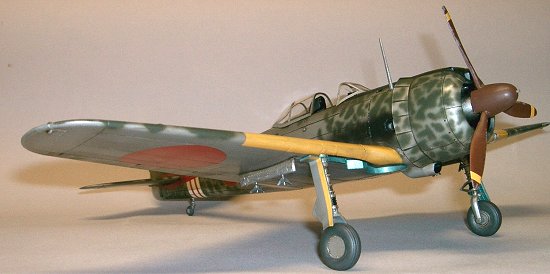 slender
fuselage reminiscent of a Nieuport 28 truly seemed to be a throwback to an
earlier era. Although the tactics that the Oscar was designed for hail from
the First World War, the basic design and construction were state of the
art for the time rendering an all metal fuselage, enclosed cockpit and
retractable landing gear. The graceful and somewhat elegant KI-43 was
fittingly bestowed the title of Hayabusa [PERIGRINE FALCON].
slender
fuselage reminiscent of a Nieuport 28 truly seemed to be a throwback to an
earlier era. Although the tactics that the Oscar was designed for hail from
the First World War, the basic design and construction were state of the
art for the time rendering an all metal fuselage, enclosed cockpit and
retractable landing gear. The graceful and somewhat elegant KI-43 was
fittingly bestowed the title of Hayabusa [PERIGRINE FALCON].
In an effort to improve the shortcomings of the KI-43 I, Nakajima refined the aerodynamics of the engine cowl and canopy, blended the carburetor intake into the upper cowling, slightly squared the wingtips and clipped about two feet off the wingspan. In addition to a crude self sealing fuel system and 13mm armored headrest/back protection the modified airframe received the improved version of the Sakae Ha115 engine rated at 1,105h.p.at take off. These among other changes yielded the KI-43IIa. Even with all the improvements it still seemed to be a David and Goliath contest with the faster, more heavily armed and armored Americans for whom usually came out on top. Although in the hands of a skilled pilot this little bird of prey could sling a lethal stone. It is believed that the great 5th Air Force, P-47 ace Neel Kirby fell to the guns of an Oscar.
| THE KIT |
In the opening scene of
Stanley Kubric’s 2001 Space Odyssey when primitive man discovers the
mysterious monolith, I 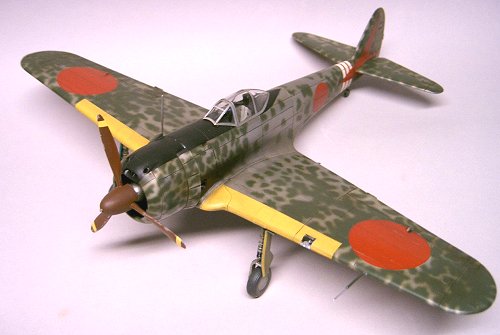 believe if you look at the lower left corner of the
screen you can see a hairy little guy building this kit. Well, it may not
be quite that old but it has been around for about 30 years. If I’m not
mistaken Revell released their 1/32nd Oscar around the same time
as Hasegawa’s. Both seem to be excellent renderings but, Revell as with
many of their 1/32nd offerings didn’t deem it necessary to do a
re-release. In complete contrast the Hasegawa KI-43 has been resurrected
more times than Jason and Michael Myers combined. As with most of their
kits they’ve gotten a lot of mileage out of the tooling and to date it is
still in circulation.
believe if you look at the lower left corner of the
screen you can see a hairy little guy building this kit. Well, it may not
be quite that old but it has been around for about 30 years. If I’m not
mistaken Revell released their 1/32nd Oscar around the same time
as Hasegawa’s. Both seem to be excellent renderings but, Revell as with
many of their 1/32nd offerings didn’t deem it necessary to do a
re-release. In complete contrast the Hasegawa KI-43 has been resurrected
more times than Jason and Michael Myers combined. As with most of their
kits they’ve gotten a lot of mileage out of the tooling and to date it is
still in circulation.
This kit is a pretty simple, straight forward build with few vices. The most complex part of this build is the engine with its fourteen separate cylinders, four crankcase halves, pushrods, exhaust collector ring and gear reduction housing [annular oil cooler optional]. Cockpit consists of a firewall/ floor, seat, stick, rudder pedals, headrest, and instrument panel. Optional position cowling flaps are offered along with a pair of external fuel tanks, gravity bombs and a choice of external oil coolers. Two styles of exhaust stacks are also supplied. Panel lines for the most part are raised with the exception of some that run the span of the wings which happen to be recessed. Clear parts consist of windscreen, canopy, port wing leading edge landing light and gun sight lenses.
| CONSTRUCTION |
The first thing to do is break out the Xacto #11 and scribing tool and engrave all those panel lines. (Feel free as your editor is WAY too lazy to do that! Ed) Existing raised lines were used as guides to lightly score the initial recesses followed up with the scribing tool. Masking tape was used to guide the #11 along the longer spans on the wings and fuselage. The scribing tool also came in handy to poke out the cowling fasteners. After all this scribing was completed the rivets were sanded off.
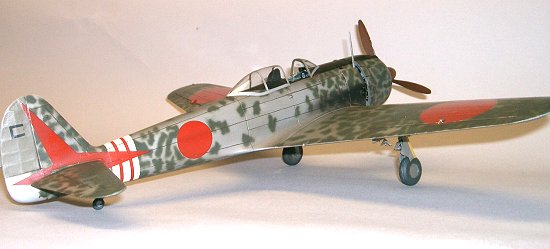 Next up was the rudimentary
cockpit. All parts and masked canopy were painted Testors o.d. #1711 with
some cockpit details painted black. The raised instruments get a dry
brushing of white after which parts are assembled. A set of masking tape
seat belts finishes this sub-assembly. Some of the upper firewall may need
to be shaved away as to let the fuselage halves fit properly.
Next up was the rudimentary
cockpit. All parts and masked canopy were painted Testors o.d. #1711 with
some cockpit details painted black. The raised instruments get a dry
brushing of white after which parts are assembled. A set of masking tape
seat belts finishes this sub-assembly. Some of the upper firewall may need
to be shaved away as to let the fuselage halves fit properly.
The engine cylinders were glued to the crankcases and painted silver with a wash of black. Testors steel adorns the gear box. The prop was painted a mix of Testors rust with a hint of black while the pushrods are silver.
Even though this is a large, old tooling the fit of the wings and fuselage and wings to fuselage is really good. The only place where I found filler to be a must was between the butterfly flaps and lower fuselage and the seams that run through the flaps and ailerons. The usual sanding of the spine, belly and wing leading edges was required.
| COLORS & MARKINGS |
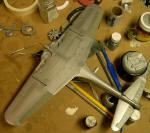 First item in the paint
shop is to prime this bird with Testors gray primer. The fabric covered
ailerons were shot RLM02. After the ailerons dried they were masked off.
Natural metal finish is a mix of Pactra chrome silver with a touch of gray
primer. Most chrome enamels tend to have that polished mirro
First item in the paint
shop is to prime this bird with Testors gray primer. The fabric covered
ailerons were shot RLM02. After the ailerons dried they were masked off.
Natural metal finish is a mix of Pactra chrome silver with a touch of gray
primer. Most chrome enamels tend to have that polished mirro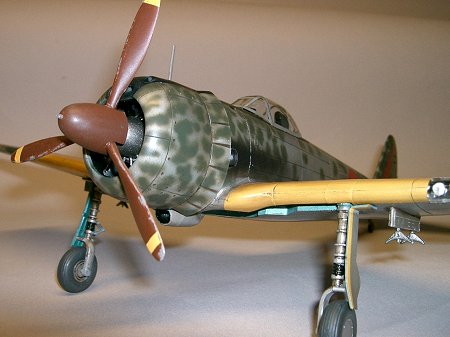 r look if not
toned down. Panel shading is achieved with a #2 pencil buffed out with Q-tips and cotton cloth. The mottling is Testors Model Masters Japanese
Army green. Black with a touch of blue makes up the anti-glare panel while
RLM04 yellow is sprayed for the leading edge i.d. panels. The wheel wells
and gear door insides get the Testors Japanese metallic blue treatment. An
application of enamel seals the paint and when dry makes way for decals.
r look if not
toned down. Panel shading is achieved with a #2 pencil buffed out with Q-tips and cotton cloth. The mottling is Testors Model Masters Japanese
Army green. Black with a touch of blue makes up the anti-glare panel while
RLM04 yellow is sprayed for the leading edge i.d. panels. The wheel wells
and gear door insides get the Testors Japanese metallic blue treatment. An
application of enamel seals the paint and when dry makes way for decals.
The markings are the product of Eagle Strike productions sheet #32026. They represent Capt. Koshiishi’s KI-43 KO of the 544th Hiko-Sentai, Kitano-Dai AB, Paramushiro island, 1944. As usual with Eagle Strike they lay down good and look great. When the decals dried the kit received its last coat of clear. Dull coat is applied using the very same clear enamel but turning up the airbrush pressure to 40 lbs. and shooting 8 to 10 inches away. This method will take the shine off a chrome bumper hitch with one less airbrush change over and the absence of that gun plugging grit found in a lot of dull coats. Finally she gets a wash of raw umber to give her that pre-owned look.
| CONCLUSIONS |
This kit may be somewhat antiquated but it still makes a fine looking Oscar. Scribing the panel lines can bring it up to date a bit but, one can still have a winner without going to the trouble. It’s a good representation of a KI-43 and fits pretty well for a thirty year old kit. The cockpit is sparse and it doesn’t matter because I can’t fit in it anyway. I would recommend this kit to anyone looking for a large scale “peregrine falcon”. This was an enjoyable build and after all isn’t that what it’s all about?
September 2004
Kit courtesy of the pile in the basement.
Copyright ModelingMadness.com. All rights reserved. No reproduction in part or in whole without express permission.
If you would like your product reviewed fairly and fairly quickly, please contact the editor or see other details in the Note to Contributors.